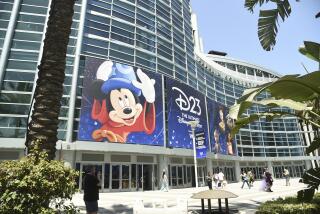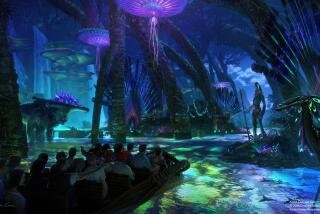Enjoying the long ride
- Share via
WALT DISNEY was a lifelong stickler who threw every controlling, detail-oriented drop of himself into his Magic Kingdom in Anaheim, creating America’s first theme park in 1955. Until then, there had only been carnivals and amusement parks, with their seedy combination of midways, rides and concessions.
To Disney, these were “dirty, phony places, run by tough-looking people,” and he dreamed of something entirely new: a place where families could come and all would be safe and clean and perfect. As Neal Gabler asserts in “Walt Disney: The Triumph of the American Imagination”: “The quintessential product of the [Disney] empire would not be fantasy, but simulated reality.... Walt Disney had crept closer still to creating and perfecting life.”
Disney recognized the importance of the false front, the idea that detail was the key to suspending our disbelief in his invented world. At the same time, he understood that he needed to eradicate even the merest hint of complexity or danger to make Disneyland the “Happiest Place on Earth.” Whether on Tom Sawyer’s Island or in his sanitized, even cuddly re-imagining of prehistoric life, Disneyland became a place where all the edges are smooth, where visitors might have a surrogate experience -- important, defining, dramatic -- without any emotional muss and fuss.
Half a century later, Disney’s influence is far-reaching and profound. His technical innovations -- tubular roller-coaster tracks, multi-car coasters, animatronics -- have become industry standards.
Yet even more important is his notion of “theming,” which has spread like a virus, turning organic spaces into lulling facades and creating nostalgia in us for places that never existed, except in some designer’s mind. “Special theming” is a staple of resorts, restaurants, spas, condos and shopping malls -- places people go to get away from reality and enjoy a controlled, enhanced, ersatz environment.
One has only to visit the Grove to witness the phenomenon up close. Like Disney’s Main Street, it looks like an imaginary small town in a world that never quite existed, with its clean streets, simple pleasures and friendly neighbors. Visitors crowd the decks of its trolley car, riding a tiny loop to nowhere, snapping pictures of each other as though they’re making memories in a real place.
And then, of course, there are the theme parks, every one of which -- Six Flags, Busch Gardens, Legoland -- bears the stamp of Disneyland. This is perhaps more true overseas, where the Disney brand itself proliferates in Japan and France.
Visionary, history-making, soul-sapping or just good, clean escapist fun -- all of it traces back to one man, who took his own obsessive dream for order and made it manifest in a park.
More to Read
The biggest entertainment stories
Get our big stories about Hollywood, film, television, music, arts, culture and more right in your inbox as soon as they publish.
You may occasionally receive promotional content from the Los Angeles Times.










